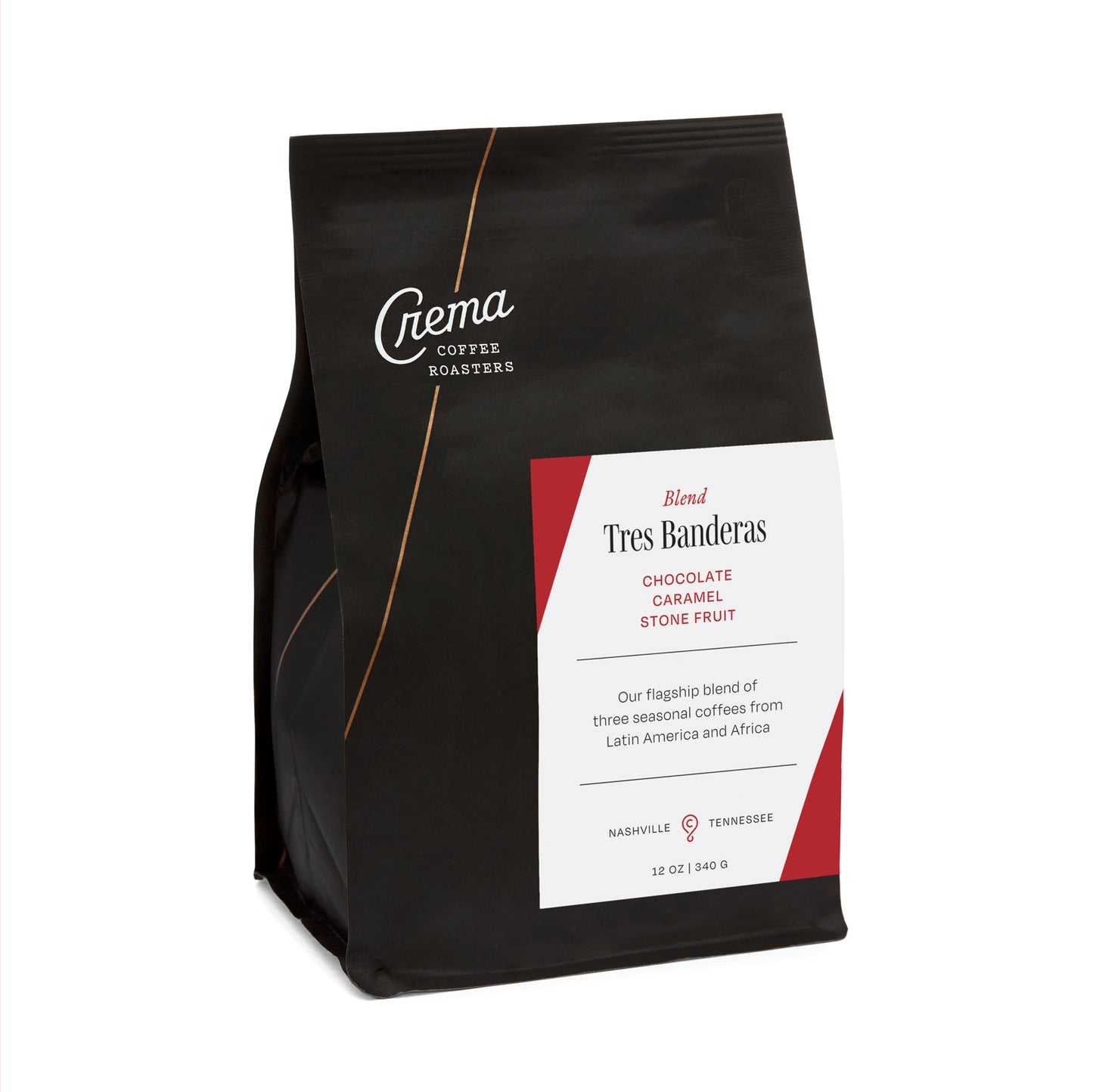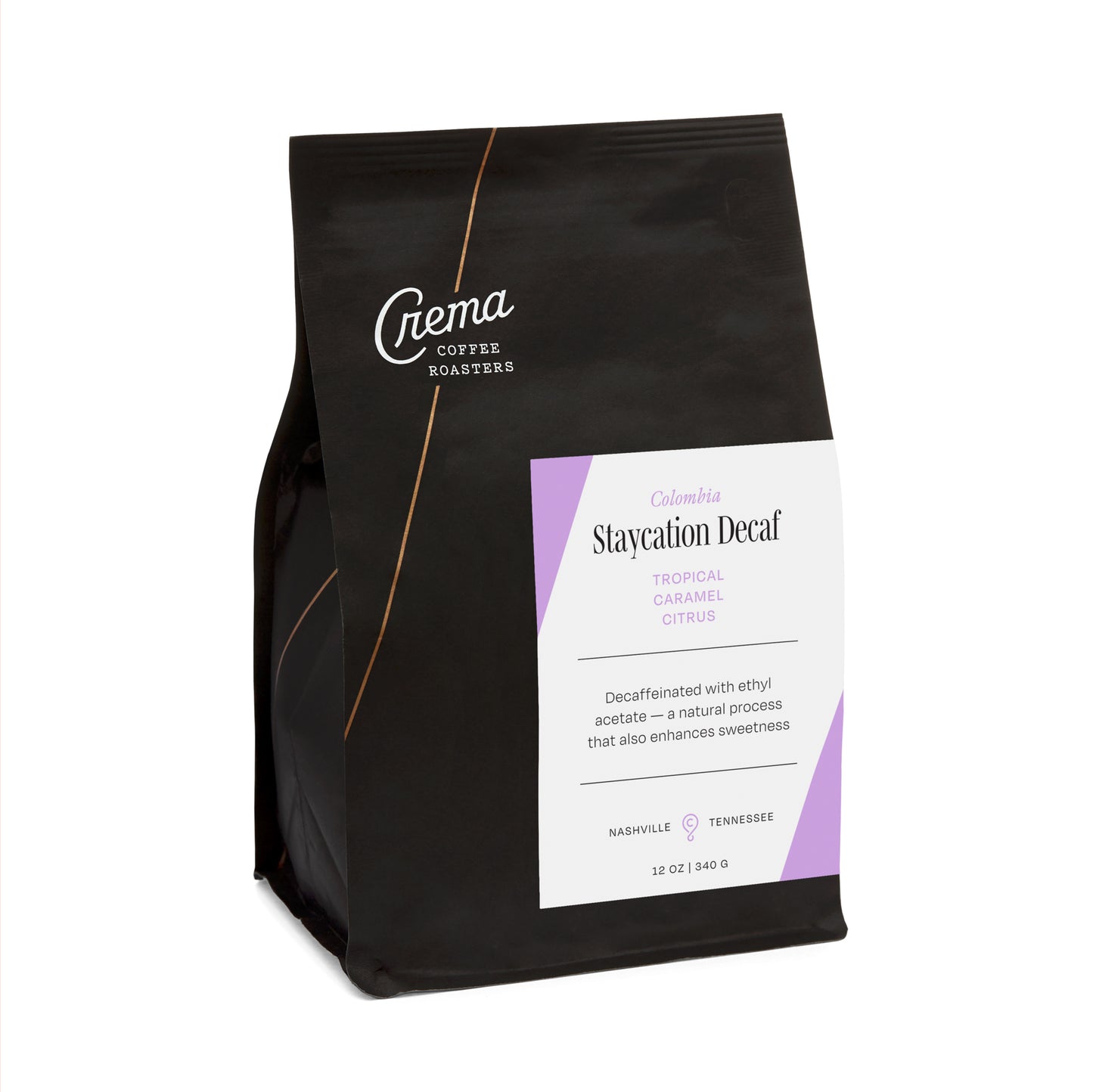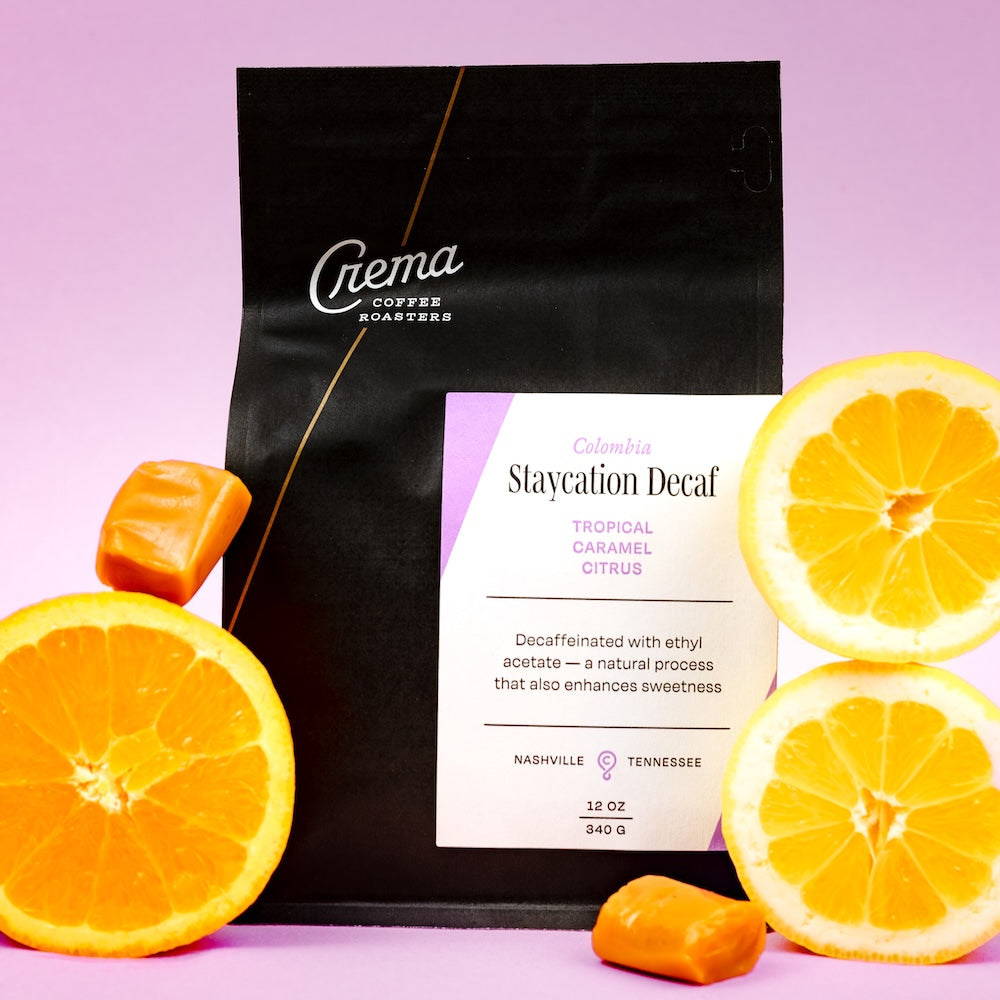HOW TO DECODE A COFFEE LABEL
You see them every time you pick up a bag of Crema coffee: a label with a bunch of info about the beans inside the bag. While many of the actual words are pretty straightforward, there’s a lot of meaning behind each characteristic of the coffee. We’ll go over the basics of what you’ll typically find on a coffee bag and provide links if you want to dive deeper into a certain topic. Put on your Nic-Cage-in-National-Treasure hat and let’s crack this coffee-label code.
Read through this post, then test your knowledge with a fun, short quiz (linked at bottom of post). Yes, you will be rewarded and no, it doesn’t matter how many you get right. Let’s get started!
WHY EVEN BOTHER WITH A COFFEE LABEL?
Coffee takes a long journey before it ends up in the hands of our roasters. We want to honor and elevate that journey by recognizing the farmers, regions, terroir and plants that produce each of the coffees we buy, roast and brew. One small way we can acknowledge this journey is by putting as much detailed information that we can on the bag of each coffee. We hope to help you break down the jumble of coffee label words into a meaningful part of your coffee buying and drinking experience. Consider this post a jumping off point; we have linked multiple other resources in each section that dive deeper into some of the more intricate topics.
Before we dive into specifics, here’s some info you’ll typically find on a coffee label/bag:
- Coffee name
- Tasting Notes
- Region/country/continent
- Coffee producer/farmer
- Coffee farm or processing mill
- Varietals of the coffee plant grown for the coffee
- Altitude at which the coffee was grown
- Processing method of the coffee
- Roast date (can be on bottom of bag)
- Amount of coffee inside the bag
- Roast level (not on Crema’s bags)

COFFEE NAME
This is the main way to refer to each coffee. It’s what you’ll see on menus in the cafes and as the main name of the coffee on our website. It’s typically the name of the coffee farm or processing mill that this coffee was grown/processed. But, it can also be the name of the producer or region/municipality. This name is typically decided by producer or coffee mill depending on what best fits the origin of each coffee.
TASTING NOTES
There’s typically 3-4 food-like words on a coffee label; these are the main flavors/sensations we tasted in the coffee when we brewed it. (They are not added flavors.) Don’t worry if you don’t taste exactly the same things; everyone has different palettes and experiences coffee differently. But, they give you a good idea of some typical flavor characteristics you might taste too.

REGION/COUNTRY/CONTINENT
There can be differing degrees of precision as to where the coffee was grown, depending on the information given at the farm/mill level.
On our labels, we denote the larger area/continent above the coffee name. Then, it’s broken down into a region/district and country. Sometimes, you’ll also see a municipality, city, town or zone before the region/district, depending on how each country or area is organized. In this example from Yabitu Koba, the continent is Africa, and the farm/mill is located in the Guji Zone of the Uraga District of the country of Ethiopia.
Try putting the regions you find on a coffee label into a map app to see where the coffee comes from. If you want to go really wild, turn on satellite view!

PRODUCER/FARMER
Perhaps one of the most important parts of the label info is the person/people who expertly planted, farmed, harvested and/or processed the coffee. Sometimes, the producer will be a person’s name or family. Other times, the coffee is produced by a co-op — a collective group of farmers who sell their coffee together. It can also be a group of households or small scale producers/farmers who all contribute to the coffee lot. But, one thing remains the same: each coffee cherry is skillfully harvested at its prime.

COFFEE FARM/PROCESSING MILL
Depending on the structure of the coffee harvest operation, you will either see a single farm name or a mill where the processing of the coffee cherry into a roastable green bean happens. As a general rule, if the producer is a single person or family, you’ll see a single farm where all of the coffee is produced. It will still get processed at a coffee mill, but all of the beans in that coffee lot come from one singular farm.
If you see a co-op, multiple contributing households/producers, you will generally have the name of the mill on the bag. This is because many of these farmers have very small lots that they most likely wouldn’t be able to sell on their own. So, they team up with other coffee producers in the area and they all bring their coffee to a central milling location to be processed.

VARIETALS
Just like other fruits, coffee plants come in different varieties. (Think about how many different kinds of apples there are: Granny Smith, Pink Lady, Honeycrisp, etc. The same is true of coffee cherries.) You’ll typically see anywhere from 1-4 different varietals in each coffee, depending on the coffee plants that are grown on the farms.
Varietals play a part in various characteristics about the coffee: the density and size of the bean, the color of the coffee cherry, its resistance to plant diseases, the total yield of the coffee plant and, of course, the flavors you taste in the final roasted product. Some of these varietals are native to the land, some were created by crossbreeding coffee plants and others were formed in a lab. Here’s a great video if you want to dive deeper. World Coffee Research also created a catalog of coffee varieties to explore characteristics of varietals.

ALTITUDE
Coffee plants that become specialty coffee are typically grown above 1,000 meters (3,500 ft) and, depending on the climate, can be grown up to 2,500+ meters (over 8,000 ft). You may see a single elevation or a range of elevations. This just depends on how the farm(s) is situated, either on flat land or scaling the side of a hill or mountain.
The altitude that a coffee is grown also plays a role in the characteristics of the final cup. Typically, the higher a coffee is grown, the more lively the flavors tend to be. This, of course, does not mean that all higher grown coffees are superior to lower grown coffees. There are many pieces of the coffee puzzle.

PROCESSING METHOD
There are multiple methods that are used to process the coffee cherry into the green coffee that is roasted. (Remember, coffee starts as a ‘seed’ locked inside a cherry-like fruit and has to be processed before in becomes a roastable green bean.) In theory, any coffee can be processed by any method if the processing mill has the right tools, technique and knowledge. But, not every coffee bean will benefit from every processing method and not every method is available to each mill.
There are 3 basic types of processing methods — fully washed, honey and natural — but there are all kinds of experimental methods that have popped up over time. Fully washed coffees have all the cherry skins and mucilage (sticky stuff around the bean) ‘washed’ off before drying. Honey/semi-washed/pulped natural coffees only have part of the cherry/mucilage washed off before drying. Natural processed coffees have the entire cherry left on during processing.

ROAST DATE
Most coffee roasters include a date the coffee was roasted somewhere on the bag, typically stamped/written on the label or on the bottom of the bag. The denotes the day that the coffee was roasted. We suggest brewing a coffee between 3 and 21 days after roasting. Coffee likes to rest a few days after being roasted, so that some of the gas inside the bean that was produced by roasting can dissipate. After 3-4 weeks, we typically see a slight degradation of the flavors of the coffee. Basically, you aren’t getting the full expression of what the coffee could be. However, we’ve brewed our coffees a couple months out from roasting and they still taste pretty good; the flavors/characteristics are just muted. So, don’t feel like you need to throw away beans that are over a few weeks old!
AMOUNT OF COFFEE
This may seem like a silly thing to pay attention to, but not every coffee roaster puts the same amount of coffee in their standard retail bags. The industry standard is typically 12 ounces, but you’ll find roasters that have a standard coffee bag size of 8, 10 or 16 ounces. (Many roasters, including Crema, also offer ‘bulk’ options of 2, 3, or 5lbs.) It’s helpful to know how much coffee you’re getting, not only because of the price, but also to know how many cups/batches you can brew with it.
TEST YOUR COFFEE LABEL KNOWLEDGE
Now that you’ve cracked the coffee-label code, let’s have a little fun with a quick coffee quiz. You’ll find a reward at the end of the quiz. And don’t worry, we’re not keeping score; everyone’s a winner!
← Older post Newer post →







